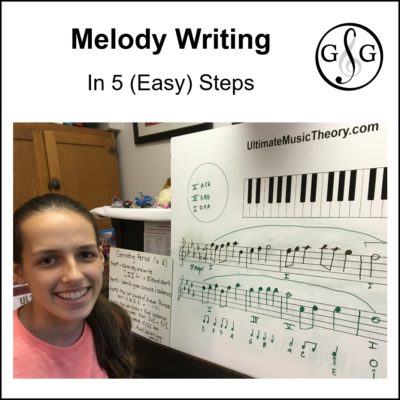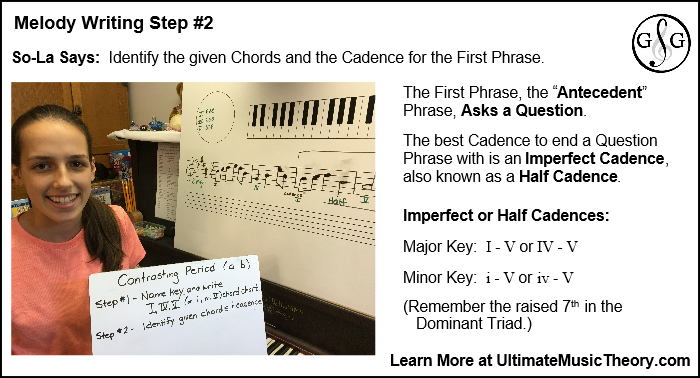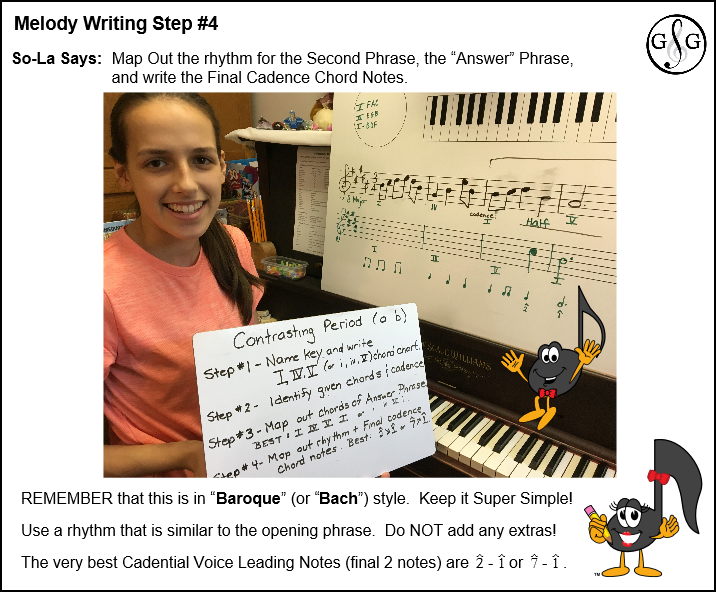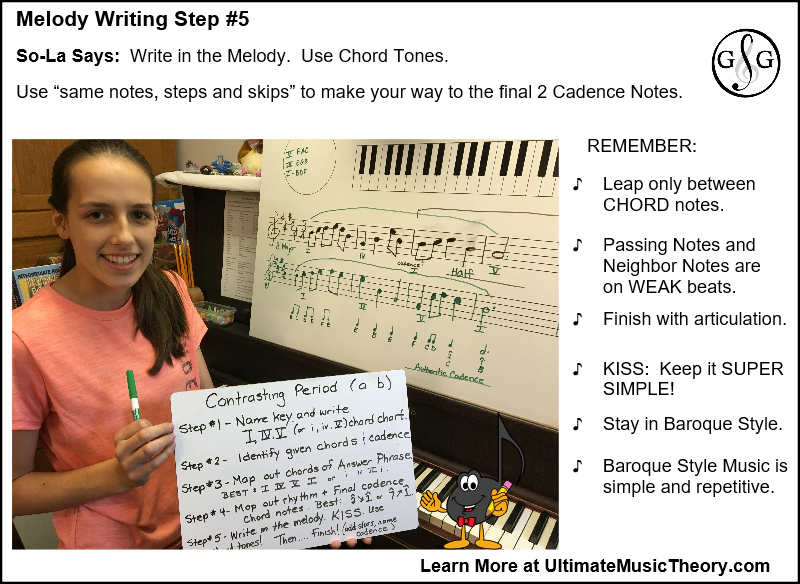Melody Writing in 5 Steps

Melody Writing can be a tricky concept to teach. So, we will make it Easy for our Students!
To start, we must remind our Students that they are not writing contemporary or modern melodies. In a Theory Examination Situation, the melody to be written is to be in "Baroque" style (think "Bach", not the Beatles!).
Baroque Style Melody Writing is simple, clean and uncomplicated. There is no syncopation, no weird and wild leaps and no crazy chromatic accidental patterns.
In this Blog, we will review how to complete Theory Examination Melody Writing Questions in 5 Easy Steps!
Melody Writing - Step #1
The most important step is this first one - Identify the Key of the Melody and write the Primary Triads.
Identifying the Key of a Melody is taught in the UMT Basic Rudiments Workbook on Page 116. Students must not assume that a melody is going to be in a Major Key.
Once the Major or minor key is established, write your Chord Chart - the notes of the Primary Triads of your key.
Just like Primary Colors (or Colours for my fellow Canadians), Primary Triads are the most important triads when completing Melody Writing.
These triads are the Tonic Triad (Major I or minor i), the Subdominant Triad (Major IV or minor iv) and the Dominant Triad (which is always Major V).

The notes of the Primary Triads (Tonic, Subdominant and Dominant) are the building blocks for easy Melody Writing in a Baroque Style in a Parallel Period or in a Contrasting Period!
Melody Writing - Step #2
Completing a Melody Writing Question in a Parallel Period (in a Major key) is taught in the UMT LEVEL 6 Supplemental Workbook. This is a requirement for the Level 6 Theory Examination
Completing a Melody Writing Question in a Contrasting Period is taught in the UMT LEVEL 7 Supplemental Workbook. Melody Writing in a Major key is a requirement for the Level 7 Theory Examination. Melody Writing in a Major or in a minor key is a requirement for the Level 8 Theory Examination.
The EASIEST way to complete Step #2 is to write measures 3 and 4 of this first 4-measure Phrase using the notes of the Tonic Triad in measure 3 and the Dominant Triad in measure 4. This outlines a HALF Cadence (also called an IMPERFECT Cadence).

The very best notes to use as the final 2 notes is the Conjunct Voice Leading of stepping from the Mediant Note to the Supertonic Note.
The Mediant (Scale Degree 3 with a "^" on it - which I cannot type as a symbol in this blog - sorry) is the third note in the Tonic Triad and really establishes that Major or minor tonality of the key.
The Supertonic (Scale Degree 2 with a "^" on it) is the fifth note in the Dominant Triad. This is an "Unstable Scale Degree". I explain this to my students by making them think of an Unstable Scale Degree as that "upwards lilt" we put into our voice when we are asking a question. It creates that expectation of an Answer (which is the 4-measure phrase to be written next)!
Other excellent Voice Leading is also possible. (See Page 48 of the LEVEL 6 Supplemental Workbook) However, I find "3 to 2" an easy voice leading to remember.
Melody Writing - Step #3
The next step is to map out the chords for the Second Phrase (measures 5 to 8).
In a Parallel (Question-Answer) Period:
- When writing Measures 5 and 6, use an exact copy of what is written in Measures 1 and 2. Done.
- Measures 7 and 8 will end with a Perfect or AUTHENTIC Cadence. Map out this Cadence by writing "V" below measure 7 and "I" (or "i") below measure 8.
In a Contrasting Period:
- The EASIEST pattern is to use a I-IV-V-I (or i-iv-V-i) phrase pattern.
- Measure 5 will use the notes from the Tonic Triad. Write "I" (or "i") below Measure 5.
- Measure 6 will use the notes from the Subdominant Triad. Write "IV" (or "iv") below Measure 6.
- Measures 7 and 8 will end with a Perfect or AUTHENTIC Cadence. Map out this Cadence by writing "V" below measure 7 and "I" (or "i") below measure 8.

Melody Writing - Step #4
When writing in Parallel Period, the rhythm for Measures 5 and 6 will be the exact same rhythm (and notes) as are found in Measures 1 and 2.
When writing in Contrasting Period, the rhythm for Measures 5 and 6 can be the exact same rhythm (with different notes) as in Measures 1 and 2. The rhythm for Measures 5 and 6 can also be slightly different, or "Contrasting".
However, it must still be similar! If there are quarter notes and eighth notes in Measures 1 and 2, use quarter notes and eighth notes in Measures 5 and 6. You could switch a couple of the note values, but do not suddenly throw in dotted quarter notes or sixteenth notes.
Plan out the rhythm for your Authentic Cadence. Depending upon the Time Signature, you have different options for Cadential Rhythms. This final cadence needs to have a good, strong rhythm. Do not make it on the final 2 beats of Measure 8!
A good tip is to make the first Cadence Chord come in on the 2nd half of measure 7, with the final Cadence Chord using the full measure of Measure 8.
Other options are definitely available but be careful. This is in Baroque (Bach) Style, so do not use any syncopated Cadential Rhythms!

Melody Writing - Step #5
It is now time to create the melody to match your rhythm. Start by using chord tone notes on the strong beats. Passing Notes and Neighbor Notes can be added between the chord tones to create patterns that move by steps.
A Passing Note is a note written between 2 chord tones that creates a pattern of "step up, step up" or "step down, step down". For example, if you are using the chord tones of F, A, C, then you would use F - step up to G (Passing Note on a weaker beat) - step up to A.
A Neighbor Note is a note written that is a step down or a step up from the chord tone, which then returns to the same chord tone. For example, if you are using the chord tones F, A, C, then you would use F - step down to E (Neighbor Note) - stepping back up to F.
A good tip is to use intervals of a 4th only between chord tones (for example, if your chord is F, A, C, you can write a melody from C up to F (up a 4th).
Remember to keep the melodies simple! Once finished, add the articulation and dynamics. Then, play your melody on the piano. How does it sound?


Having Fun with Melody Writing - On a Personal Note
The student featured in this Blog is a lovely young lady named Olivia. Olivia took part in my Summer Theory Groups in order to prepare for her Level 7 Theory Exam. She received a 94% on her Level 7 Theory and a 92% on her Level 7 Piano.
My granddaughter Abigail loves to be a part of my Music Teaching and, during the Summer, she spent many an hour in the Backpack bouncing, singing and counting along with my piano and theory students.
And yes - that is me in the middle. You may note that I have grey gloves on. These are compression gloves that I wear for support with my Osteoarthritis.
Using the Ultimate Music Theory Whiteboard is a MUST for teaching Melody Writing. Students can easily erase anything if they change their mind. (It is also easy for me to write on!)
While there are many "ways" to complete Melody Writing, these 5 steps really work for me and my students. I hope that they inspire you too!
Ultimate Music Teachers Membership
♪ LEARN ♪ PLAN ♪ TEACH ♪ GROW
The One & ONLY Ultimate Music Teachers Membership
To Become A UMT PRO!
Your Success Path Starts Here - Go To TeachUMT.com Today!
Keep on Learning... With a Smile and a Song!
Shelagh McKibbon-U'Ren



THANK YOU SO MUCH for posting this! Just what I needed today!